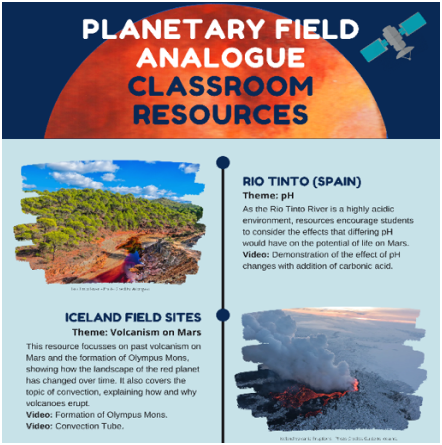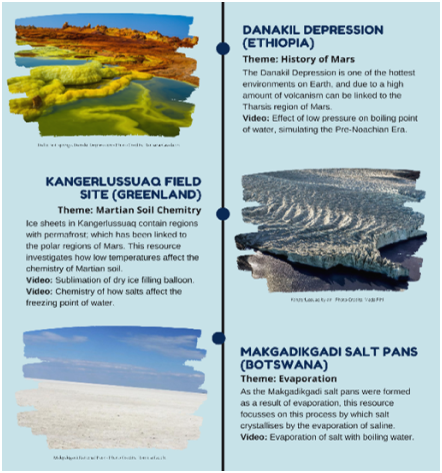Educational Resources for the EPN24 Planetary Field Analogue Sites
- 1Thompson STEM Engagement, United Kingdom of Great Britain and Northern Ireland (tony@thompsonstem.co.uk)
- 2The University of Edinburgh, United Kingdom of Great Britain and Northern Ireland (r.cane@ed.ac.uk)
- 3Wandering Planet (planeta.errante.astro@gmail.com)
- 4Faulkes Telescope Project, United Kingdom of Great Britain and Northern Ireland (paul.roche@faulkes-telescope.com)
- 5Cardiff University, United Kingdom of Great Britain and Northern Ireland (paul.roche@astro.cf.ac.uk)
The Europlanet 2024 Research Infrastructure (RI) provides free access to the world’s largest collection of planetary simulation and analysis facilities. The project is funded through the European Commission’s Horizon 2020 programme and runs for four years from February 2020 until January 2024. The Transnational Access (TA) programme supports all travel and local accommodation costs for European and international researchers to visit 24 laboratory facilities and 5 Planetary Field Analogues (PFA) [1].
As part of the education and inspiration tasks associated with Europlanet 2024 RI, we have produced classroom resources aimed at age 10-14 year olds relating the conditions found within the PFA sites to astrobiology and the habitability of Mars.
These resources have been produced around all PFA sites:
- Rio Tinto River (Spain)
- Iceland Field Sites (Iceland)
- Danakil Depression (Ethiopia)
- Kangerlussuaq Field Site (Greenland)
- Makgadikgadi Salt Pans (Botswana)
These resources link in with common areas found in worldwide STEM curriculums, such as volcanism, pressure, pH and evaporation. To achieve this, we have filmed lab-based demonstrations and included them in a classroom lesson plan alongside teachers' notes. In addition, each lesson plan focuses on how the conditions of the PFA’s could affect the habitability of Mars, as can be seen in Figure 1.
Following studies such as Salimpour et al 2020 [2], highlighting the extent to which astronomy has been incorporated into school curriculums, we have chosen to highlight three subject areas with lower representation in high schools into our resources; physics, space exploration and astrobiology.
As these analogue sites can be linked to more planetary bodies than just Mars, our next steps are to create similar resources based around the habitability of the icy moons of the Solar System.


Figure 1. Outline of resource plans for Europlanet Planetary Field Analogues.
References: [1] The Europlanet Society, TA1 Planetary Field Analogues (PFA). Available at: https://www.europlanet-society.org/europlanet-2024-ri/ta1-pfa. [2] Salimpour, S., Bartlett, S., Fitzgerald, M.T. et al. The Gateway Science: a Review of Astronomy in the OECD School Curricula, Including China and South Africa. Res Sci Educ (2020). https://doi.org/10.1007/s11165-020-09922-0
Acknowledgement: Europlanet 2024 RI has received funding from the European Union’s Horizon 2020 research and innovation programme under grant agreement No 871149.
How to cite: Cane, R., Thompson, T., Utreras, J., and Roche, P.: Educational Resources for the EPN24 Planetary Field Analogue Sites, Europlanet Science Congress 2020, online, 21 September–9 Oct 2020, EPSC2020-612, https://doi.org/10.5194/epsc2020-612, 2020

